C–O Stable Isotopes Geochemistry of Tunisian Nonsulfide Zinc Deposits: A First Look
Abstract
:1. Introduction
2. Geological, Climatic and Metallogenic Setting of Tunisia
2.1. Regional Geology
2.2. Current and Past Climatic Conditions
2.3. Distribution and General Characteristics of Zn-Pb Ore Deposits
- Group 1: Zn-Pb mineralizations subdivided into two sub-groups: (a) polymetallic veins (Pb-Zn-Cu-As-Hg) along faults and (b) clastic-dominated Zn-Pb deposits within Late Miocene siliciclastic rocks and lacustrine limestones. Most of these deposits are located in the Nappe Zone of the Tellian Atlas (e.g., Jebel Hallouf, Sidi Bouaouane, Sidi Driss, Djebba) [1,40].
- Group 2: Pb-Zn-(Sr) stratabound replacement-type deposits within Triassic evaporite solution breccias at the contact zones of salt diapirs, salt glaciers or salt sheets and the surrounding Cretaceous to Miocene rocks. Most deposits (e.g., Fedj el Adoum, Bou Grine, Kebbouch, Bou Khil, Garn Halfaya, Zag Ettir, Doggra) are located within the Diapir Zone, some others (e.g., Aïn Allegua, Aguiba, Bechateur) in the Nappe Zone ([2,41]).
- Group 4: Ba-F-(Pb-Zn) stratabound replacement-type and cavity-filling deposits developed within Aptian platform/reef limestone near salt diapirs involving Triassic evaporites. Most deposits are located in the western area of the Diapir Zone and the Graben Zone. Two distinct mineral assemblages occur: Subgroup 4a with Ba-F-(Pb-Zn) (e.g., Mesloula, Mzouzia, Belkfif deposits in Algeria; and Bou Jaber in Tunisia); and Subgroup 4b consisting of Ba-(Pb-Zn) deposits (e.g., Slata Fer, Hamra, Ajred, Trozza) [39,45,46]. A Ba-(Pb-Zn) mineralization is also present in early Eocene phosphorite-rich rocks (Sekarna) [47].
- Group 5: stratabound and vein-type F-Ba-(Pb-Zn) deposits occurring in the upper parts of two Jurassic carbonate platform units: the Oust Limestone (Early Jurassic) hosts the El Khol, Stah and Hammam Jedidi deposits, while the Ressas Limestone (Late Jurassic) hosts the Mecella, Ressas, Hammam Zriba and Sidi Taya deposits.
3. Nonsulfide Ore Deposits and Their Sulfide Protores: Geological and Mineralogical Background
3.1. Nappe Zone
3.2. Diapir Zone
3.3. Graben Zone
3.4. North South Axis Deposits
4. Materials and Methods
5. Results: Mineralogy and Stable Isotope Geochemistry of the Analyzed Samples
6. Discussion
7. Conclusions
Acknowledgments
Author Contributions
Conflicts of Interest
References
- Rouvier, R.; Perthuisot, V.; Mansouri, A. Pb-Zn deposits and salt bearing diapirs in Southern Europe and North Africa. Econ. Geol. 1985, 80, 666–687. [Google Scholar] [CrossRef]
- Sheppard, S.M.F.; Charef, A.; Bouhlel, S. Diapirs and Zn-Pb mineralization: A general model based on Tunisian (N. Africa) and Gulf Coast (USA) deposits. Carbonate-Hosted Lead-Zinc Depos. Soc. Econ. Geol. 1996, 4, 230–243. [Google Scholar]
- Bouhlel, S. Carbonate hosted Mississippi Valley-type Pb-Zn deposits in Tunisia (Eastern Atlasic Belt). In Mineral Deposit Research: Meeting the Global Challenge, Proceedings of the Eighth Biennial SGA Meeting, Beijing, China, 18–21 August 2005; Mao, J., Bierlein, F.P., Eds.; Springer: Berlin/Heidelberg, Germany, 2005; Volume 3, pp. 19–22. [Google Scholar]
- Bouhlel, S.; Leach, D.L.; Johnson, C.A.; Lehmann, B. Ore Textures and Isotope Signatures of the Peridiapiric Carbonate-Hosted Pb-Zn deposit of Bougrine, Tunisia. In Proceedings of the 10th Biennial Meeting of the Society for Geology Applied to Mineral Deposits, Townsville, Australia, 17–20 August 2009; Volume 1, pp. 409–412. [Google Scholar]
- Bouhlel, S.; Leach, D.L.; Johnson, C.A.; Marsh, E.; Salmi-Laouar, S.; Banks, D.A. A salt diapir-related Mississippi Valley-type deposit: the Bou Jaber Pb-Zn-Ba-F deposit, Tunisia: Fluid inclusion and isotope study. Miner. Depos. 2016, 51, 749–780. [Google Scholar] [CrossRef]
- Gottis, C.; Sainfeld, P. Les Gites Métallifères Tunisien. In Proceedings of the XIXème Congrès Géologique International, Alger, Algeria, September 1952; p. 104. [Google Scholar]
- Sainfeld, P. Les gîtes plombo-zincifères de Tunisie. Ann. Min. Géol. Tunis 1952, 9, 258. [Google Scholar]
- Sainfeld, P. The lead-zinc-bearing deposits of Tunisia. Econ. Geol. 1956, 51, 150–177. [Google Scholar] [CrossRef]
- Bouhlel, S.; Fortuné, J.P. Contribution à l’étude minéralogique et géochimique des minéraux de Pb-Zn-Cu de la province fluorée tunisienne. Notes Serv. Géol. Tunis 1985, 51, 155–176. [Google Scholar]
- Boni, M.; Mondillo, N. The “Calamines” and the “Others”: The great family of supergene nonsulfide zinc ores. Ore Geol. Rev. 2015, 67, 208–233. [Google Scholar] [CrossRef]
- Bouaziz, S.; Barrier, E.; Soussi, M.; Turki, M.M.; Zouari, H. Tectonic evolution of the northern African margin in Tunisia from paleostress data and sedimentary record. Tectonophysics 2002, 3571, 227–253. [Google Scholar] [CrossRef]
- Burollet, P.F. Structures and tectonics of Tunisia. Tectonophysics 1991, 195, 359–369. [Google Scholar] [CrossRef]
- Turki, M.M. Polycinématique et Contrôle Sédimentaire Associé sur la Cicatrice Zaghouan-Nebhana. Ph.D. Thesis, Faculty of Sciences of Tunis, Tunis, Tunisia, 1985. [Google Scholar]
- Nicholson, S. The nature of rainfall variability over African on time scales of decades to millennia. Glob. Planet Chang. 2000, 26, 137–158. [Google Scholar] [CrossRef]
- Janowiak, J. An investigation of interannual rainfall variability in Africa. J. Clim. 1988, 1, 240–255. [Google Scholar] [CrossRef]
- Semazzi, F.; Mehta, V.; Sud, Y. An investigation of the relationship between sub-Saharan rainfall and global sea surface temperatures. Atmos. Ocean 1988, 26, 118–138. [Google Scholar] [CrossRef]
- Feakins, S.J.; de Menocal, P.B. Global and African regional climate during the Cenozoic. In Cenozoic Mammals of Africa; Werdelin, L., Sanders, W.J., Eds.; University of California Press: Berkeley, CA, USA, 2010; pp. 45–55. [Google Scholar]
- Hurrell, J.W. Decadal trends in the North Atlantic Oscillation: Regional temperatures and precipitation. Science 1995, 269, 676–679. [Google Scholar] [CrossRef] [PubMed]
- Knippertz, P.; Ulbrich, U.; Marques, F.; Corte-Real, J. Decadal changes in the link between El Niño and springtime North Atlantic oscillation and European–North African rainfall. Int. J. Climatol. 2003, 23, 1293–1311. [Google Scholar] [CrossRef]
- Dansgaard, W.S.; Johnsen, S.; Glausen, H.B.; Dahl-Jensen, D.; Gundestrup, N.S.; Hammer, C.U.; Hvidberg, C.S.; Steffesen, J.; Sveinsbjörnsdottir, A.E.; Jouzel, J.; et al. Evidence for general instability of past climate from a 250-kyr ice core record. Nature 1993, 364, 218–220. [Google Scholar] [CrossRef]
- Stott, L.; Kenneth, J.P. Antarctic Paleogene planktonic foraminifer biostratigraphy, ODP Leg 113, Sites 689 and 690. In Proceedings of the Ocean Drilling Program, Scientific Results, Los Angeles, CA, USA, 1990; Volume 113, pp. 549–569. [Google Scholar]
- Le Houerou, H. Climate, flora and fauna changes in the Sahara over the past 500 million years. J. Arid. Environ. 1997, 37, 619–647. [Google Scholar] [CrossRef]
- Bolle, M.P.; Adatte, T.; Keller, G.; Von Salis, K.; Burns, S. The Paleocene-Eocene transition in the southern Tethys (Tunisia): Climatic and environmental fluctuations. Bull. Soc. Géol. Fr. 1999, 170, 661–680. [Google Scholar]
- Flower, B.P.; Kennett, J.P. The middle Miocene climatic transition: East Antarctica ice sheet development, deep ocean circulation and global carbon cycling. Palaeogeogr. Palaeoclimatol. Palaeoecol. 1994, 108, 537–555. [Google Scholar] [CrossRef]
- Zachos, J.; Pagani, M.; Sloan, L.; Thomas, E.; Billups, K. Trends, rhythms, and aberrations in global climate 65 Ma to present. Science 2001, 292, 686–693. [Google Scholar] [CrossRef] [PubMed]
- John, C.M.; Mutti, M.; Adatte, T. Mixed carbonate-siliciclastic record on the North African margin (Malta)—Coupling of weathering processes and mid Miocene climate. Geol. Soc. Am. Bull. 2003, 115, 217–229. [Google Scholar] [CrossRef]
- Griffin, D.L. Aridity and humidity: two aspects of the late Miocene climate of North Africa and the Mediterranean. Palaeogeogr. Palaeoclimatol. Palaeoecol. 2002, 182, 65–91. [Google Scholar] [CrossRef]
- Dupont, L.; Leroy, S. Steps towards drier climatic conditions in Northwestern Africa during the Upper Pliocene. In Paleoclimate and Evolution with Emphasis on Human Origins; Vrba, E., Denton, G., Partridge, T., Burckle, L., Eds.; Yale University Press: New Haven, CT, USA, 1995; pp. 289–297. [Google Scholar]
- Haywood, A.; Sellwood, B.; Valdes, P. Regional warming: Pliocene (3 Ma) paleoclimate of Europe and Mediterranean. Geology 2000, 38, 1063–1066. [Google Scholar] [CrossRef]
- De Menocal, P.B. African climate change and faunal evolution during the Pliocene–Pleistocene. Earth Planet Sci. Lett. 2004, 220, 3–24. [Google Scholar] [CrossRef]
- Tiedemann, R.; Sarnthein, M.; Shackleton, N.J. Astronomical timescale for the Pliocene Atlantic δ18O and dust flux records of ODP Site 659. Paleoceanography 1994, 9, 619–638. [Google Scholar] [CrossRef]
- De Menocal, P.B. Plio-Pleistocene African climate. Science 1995, 270, 53–59. [Google Scholar] [CrossRef]
- De Menocal, P.; Bloemendal, J. Plio-Pleistocene climatic variability in subtropical Africa and the paleoenvironment of hominid evolution: A combined data-model approach. In Paleoclimate and Evolution with Emphasis on Human Origins; Vrba, E., Denton, G., Partridge, T., Burckle, L., Eds.; Yale University Press: New Haven, CT, USA, 1995; pp. 262–288. [Google Scholar]
- Pokras, E.; Mix, A.C. Earth’s precession cycle and Quaternary climatic change in tropical Africa. Nature 1987, 326, 486–487. [Google Scholar] [CrossRef]
- De Menocal, P.B.; Ortiz, J.; Guilderson, T.; Adkins, J.; Sarnthein, M.; Baker, L.; Yarusinsky, M. Abrupt onset and termination of the African Humid Period: Rapid climate responses to gradual insolation forcing. Quatern. Sci. Rev. 2000, 19, 347–361. [Google Scholar] [CrossRef]
- Haynes, C.V.; Mead, A.R. Radiocarbon dating and paleoclimatic significance of sub-fossil Limicolaria in NW Sudan. Quatern. Res. 1987, 28, 86–89. [Google Scholar] [CrossRef]
- Rognon, P. Late Quaternary climatic reconstruction for the Maghreb (North Africa). Palaeogeogr. Palaeoclimatol. Palaeoecol. 1987, 58, 11–34. [Google Scholar] [CrossRef]
- Kropelin, S.; Soulie-Marsche, I. Charophyte remains from Wadi Howar as evidence for deep mid-Holocene freshwater lakes in the eastern Sahara of northwest Sudan. Quatern. Res. 1991, 36, 210–223. [Google Scholar] [CrossRef]
- Bouhlel, S. Gîtologie, Minéralogie et Essai de Modélisation des Minéralisations à F-Ba-Sr-Pb-Zn-(S) Associées aux Carbonates (Jurassiques et Cretacés) et aux Diapirs Triasiques: Gisements de Stah-Kohol, Zriba-Guebli, Bou Jaber et Fej Lahdoum (Tunisie Septentrionale). Ph.D. Thesis, Sciences Géologiques, Université de Tunis, Tunis, Tunisian Republic, 1993; p. 293. [Google Scholar]
- Decrée, S.; Marignac, C.; De Putter, T.; Deloule, E.; Liégeois, J.P.; Demaiffe, D. Pb-Zn mineralization in a Miocene regional extensional context: The case of the Sidi Driss and the Douahria ore deposits (Nefza mining district, Northern Tunisia). Ore Geol. Rev. 2008, 34, 285–303. [Google Scholar] [CrossRef]
- Bouhlel, S.; Johnson, C.A.; Leach, D.L. The peridiapiric-type Pb–Zn deposit at Fedj El Adoum, Tunisia: geology, petrography, and stable isotopes. In Proceedings of the Ninth Biennial SGA Meeting, Dublin, Ireland, 20–23 August 2007; pp. 323–325. [Google Scholar]
- Orgeval, J.J. Peridiapiric metal concentration: Example of the Bou Grine deposit (Tunisian Atlas). In Sediment-Hosted Zn-Pb Ores; Springer: Berlin/Heidelberg, Germany, 1994; pp. 354–389. [Google Scholar]
- Schmidt, S.C. Re-activation of the Bougrine Mine, Tunisia. In Proceedings of the 101st Annual General Meeting of the Canadian Institute Mining, Metallurgy and Petroleum-Mining, Calgary, AB, Canada, May 1999. [Google Scholar]
- Bejaoui, J.; Bouhlel, S.; Sellami, A.; Braham, A. Geology, mineralogy and fluid inclusion study of Oued Jebs Pb–Zn–Sr deposit; comparison with the Bou Grine deposit (diapirs zone, Tunisian atlas). Arab. J. Geosci. 2014, 7, 2483–2497. [Google Scholar] [CrossRef]
- Jrad, L.; Perthuisot, V. Diapirisme, orogenèse et minéralisation Pb-Zn en Afrique du Nord: Exemple des gisements du J. Ajred et du J. Hamra en Tunisie centrale. C. R. Acad. Sci. Paris 1995, 321, 721–728. [Google Scholar]
- Bejaoui, J.; Bouhlel, S.; Cardellach, E.; Canals, À.; Perona, J.; Piqué, À. Mineralization and fluid inclusion studies of the Aptian carbonate-hosted Pb-Zn-Ba ore deposits at Jebel Hamra. Central Tunisia. J. Geochem. Explor. 2013, 128, 136–146. [Google Scholar] [CrossRef]
- Garnit, H.; Bouhlel, S.; Barca, D.; Johnson, C.A.; Chtara, C. Phosphorite-hosted zinc and lead mineralization in the Sekarna deposit (Central Tunisia). Miner. Deposita 2012, 47, 545–562. [Google Scholar] [CrossRef]
- Rouvier, R. Géologie de L’extrême-Nord Tunisien: Tectoniques et Paléogéographies Superposées à L’extrémité Orientale de la Chaine Nord-Maghrebine. Ph.D. Thesis, Université Pierre et Marie Curie, Paris, France, 1977. [Google Scholar]
- Martinez, C.; Truillet, R. Evolution paléogéographique et structurale de la Tunisie. Mem. Soc. Geol. It. 1987, 38, 35–45. [Google Scholar]
- Ben Ayed, N. Évolution tectonique de L’avant-Pays de la Chaîne Alpine de Tunisie du Début du Mésozoïque à l’Actuel. Ph.D. Thesis, Université Paris Sud-Paris XI, Paris, France, 1986. [Google Scholar]
- Chihi, L. Les Fossés Néogènes à Quaternaires de la Tunisie et de la mer Pélagienne: Leur Étude Structurale et Leur Signification Dans le Cadre Géodynamique De La Méditerranée Centrale. Ph.D. Thesis, Université Tunis II, Tunis El Manar, Tunisia, 1995; p. 566. [Google Scholar]
- Rouvier, R. Minéralisations plombo-zincifères et phenomene karstique. Exemple tunisien: Le gisement du Djebel Hallouf. Miner. Deposita 1971, 6, 196–206. [Google Scholar] [CrossRef]
- Mansouri, A. Gisements de Pb-Zn et Karstification en Milieu Continental: Le District Minier du Djebel Hallouf-Sidi Bou Aouane (Tunisie septentrionale). Ph.D. Thesis, Université Pierre et Marie Curie, Paris, France, 1980. [Google Scholar]
- Charef, A. La nature et le rôle des phases fluides associées à la minéralisation Pb-Zn dans les formations carbonatées et leurs conséquences métallogéniques: études des inclusions fluides et des isotopes (H, C, O, S, Pb) des gisements des Malines (France), Jebel Hallouf-Sidi Bou Aouane et Fedj-el-Adoum (Tunisie). Ph.D. Thesis, Université Nancy, Nancy, France, 1986. [Google Scholar]
- Mohamed-Naceur, M. Étude de Minéralisations Vanadifères dans les Poches Karstiques du Jebel Goraa (Djebba-Tunisie). Ph.D. Thesis, Université de Paris-Sud, Orsay, France, 1973. [Google Scholar]
- Charef, A.; Sheppard, S.M. Pb-Zn mineralization associated with diapirism: Fluid inclusion and stable isotope (H, C, O) evidence for the origin and evolution of the fluids at Fedj-el-Adoum, Tunisia. Chem. Geol. 1987, 61, 113–134. [Google Scholar] [CrossRef]
- Perthuisot, V. Diapirism in northern Tunisia. J. Struct. Geol. 1981, 33, 231–235. [Google Scholar] [CrossRef]
- Floridia, S. La province fluorée tunisienne. Aperçu géologique et métallogénique. Livre jubilaire M. Solignac. Ann. Min. Géol. Tunis. 1973, 2, 477–479. [Google Scholar]
- Thibieroz, J. Hammam Jedidi et Hammam Zriba: Etude Géologique et Minière de Deux Gisements Stratiformes Dans le Cadre de la Province Fluorée Tunisienne; L’association des Concentrations Fluorées Aux Surfaces D’émersion. Master’s Thesis, Université Paris VI, Paris, France, 1974. [Google Scholar]
- Jemmali, N.; Souissi, F.; Vennemann, T.W.; Carranza, E.J.M. Genesis of the Jurassic Carbonate-Hosted Pb-Zn deposits of Jebel Ressas (Noth-Eastern Tunisia): Evidence from Mineralogy, Petrography and Trace Metal Contents and Isotope (O, C, S, Pb) Geochemistry. Res. Geol. 2011, 61, 367–383. [Google Scholar] [CrossRef]
- Souissi, F.; Dandurand, J.L.; Fortune, J.P. Thermal and chemical evolution of fluids during fluorite deposition in the Zaghouan province, north-eastern Tunisia. Miner. Deposita 1997, 32, 257–270. [Google Scholar] [CrossRef]
- Morgan, M.A.; Grocott, J.; Moody, R.T. The structural evolution of the Zaghouan-Ressas structural belt, northern Tunisia. Geol. Soc. Lond. Spec. Publ. 1998, 132, 405–422. [Google Scholar] [CrossRef]
- Souissi, F.; Jemmali, N.; Souissi, R.; Dandurand, J.L. REE and isotope (Sr, S, and Pb) geochemistry to constrain the genesis and timing of the F–(Ba–Pb–Zn) ores of the Zaghouan district (NE Tunisia). Ore Geol. Rev. 2013, 55, 1–12. [Google Scholar] [CrossRef]
- Kim, S.T.; Mucci, A.; Taylor, B.E. Phosphoric acid fractionation factors for calcite and aragonite between 25 and 75 °C: Revisited. Chem. Geol. 2007, 246, 135–146. [Google Scholar] [CrossRef]
- Rosenbaum, J.; Sheppard, S.M. An isotopic study of siderites, dolomites and ankerites at high temperatures. Geochim. Cosmochim. Acta 1986, 50, 1147–1150. [Google Scholar] [CrossRef]
- Gilg, H.A.; Struck, U.; Vennemann, T.; Boni, M. Phosphoric acid fractionation for smithsonite and cerussite between 25 and 72 °C. Geoch. Cosmochim. Acta 2003, 67, 4049–4055. [Google Scholar] [CrossRef]
- Gilg, H.A.; Boni, M.; Hochleitner, R.; Struck, U. Stable isotope geochemistry of carbonate minerals in supergene oxidation zones of Zn–Pb deposits. Ore Geol. Rev. 2008, 33, 117–133. [Google Scholar] [CrossRef]
- De Lamotte, D.F.; Saint Bezar, B.; Bracène, R.; Mercier, E. The two main steps of the Atlas building and geodynamics of the western Mediterranean. Tectonics 2000, 19, 740–761. [Google Scholar] [CrossRef]
- Decrée, S.; Marignac, C.; Abidi, R.; Jemmali, N.; Deloule, E.; Souissi, F. Tectonomagmatic Context of Sedex Pb–Zn and Polymetallic Ore Deposits of the Nappe Zone Northern Tunisia, and Comparisons with MVT Deposits in the Region. In The Mineral Deposits of North Africa; Springer: Berlin/Heidelberg, Germany, 2016; pp. 497–525. [Google Scholar]
- Reichert, J.; Borg, G. Numerical simulation and a geochemical model of supergene carbonate-hosted nonsulphide zinc deposits. Ore Geol. Rev. 2008, 33, 134–151. [Google Scholar] [CrossRef]
- Bruch, A.; Uhl, D.; Mosbrugger, V. Miocene climate in Europe—Patterns and evolution: A first synthesis of NECLIME. Palaeogeogr. Palaeoclimatol. Palaeoecol. 2007, 253, 1–7. [Google Scholar] [CrossRef]
- Desprat, S.; Combourieu-Nebout, N.; Essallami, L.; Sicre, M.A.; Dormoy, I.; Peyron, O.; Siani, G.; Bout Roumazeilles, V.; Turon, J.L. Deglacial and Holocene vegetation and climatic changes in the southern Central Mediterranean from a direct land–sea correlation. Clim. Past 2013, 9, 767–787. [Google Scholar] [CrossRef]
- Hamed, Y. Stable isotope ratios in meteoric waters in El Kef Region, Northwestern Tunisia: Implications for changes of moisture sources. J. Earth Sci. Clim. Chang. 2014, 5, 203. [Google Scholar]
- Mejri, S.; Chekirbane, A.; Maki Tsujimura, M.; Mlayah, A.; Boughdiri, M. Tracing groundwater salinization processes in an inland aquifer: A hydrogeochemical and isotopic approach in Sminja aquifer, Northeast of Tunisia. In Proceedings of the International Conference on African Large River Basins Hydrology, Hammamet, Tunisia, 26–30 October 2015. [Google Scholar]
- Tricart, P.; Torelli, L.; Argnani, A.; Rekhiss, F.; Zitellini, N. Extensional collapse related to compressional uplift in the Alpine Chain off northern Tunisia (Central Mediterranean). Tectonophysics 1994, 238, 317–329. [Google Scholar] [CrossRef]
- Fourré, E.; Di Napoli, R.; Aiuppa, A.; Parello, F.; Gaubi, E.; Jean-Baptiste, P.; Allard, P.; Calabrese, S.; Mamou, A.B. Regional variations in the chemical and helium-carbon isotope composition of geothermal fluids across Tunisia. Chem. Geol. 2011, 288, 67–85. [Google Scholar] [CrossRef] [Green Version]
- Dhia, H.B. The geothermal gradient map of central Tunisia: comparison with structural, gravimetric and petroleum data. Tectonophysics 1987, 142, 99–109. [Google Scholar] [CrossRef]
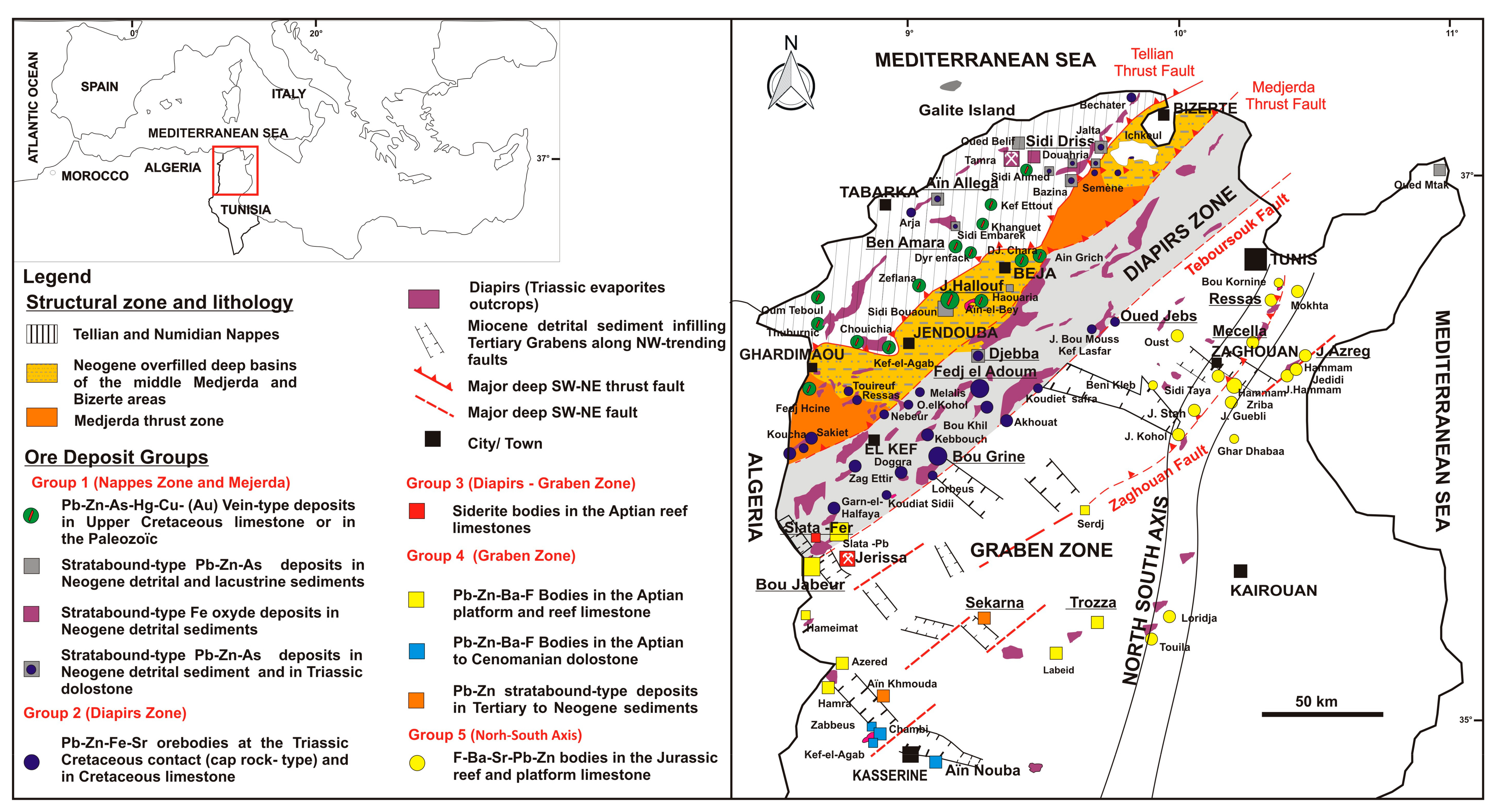

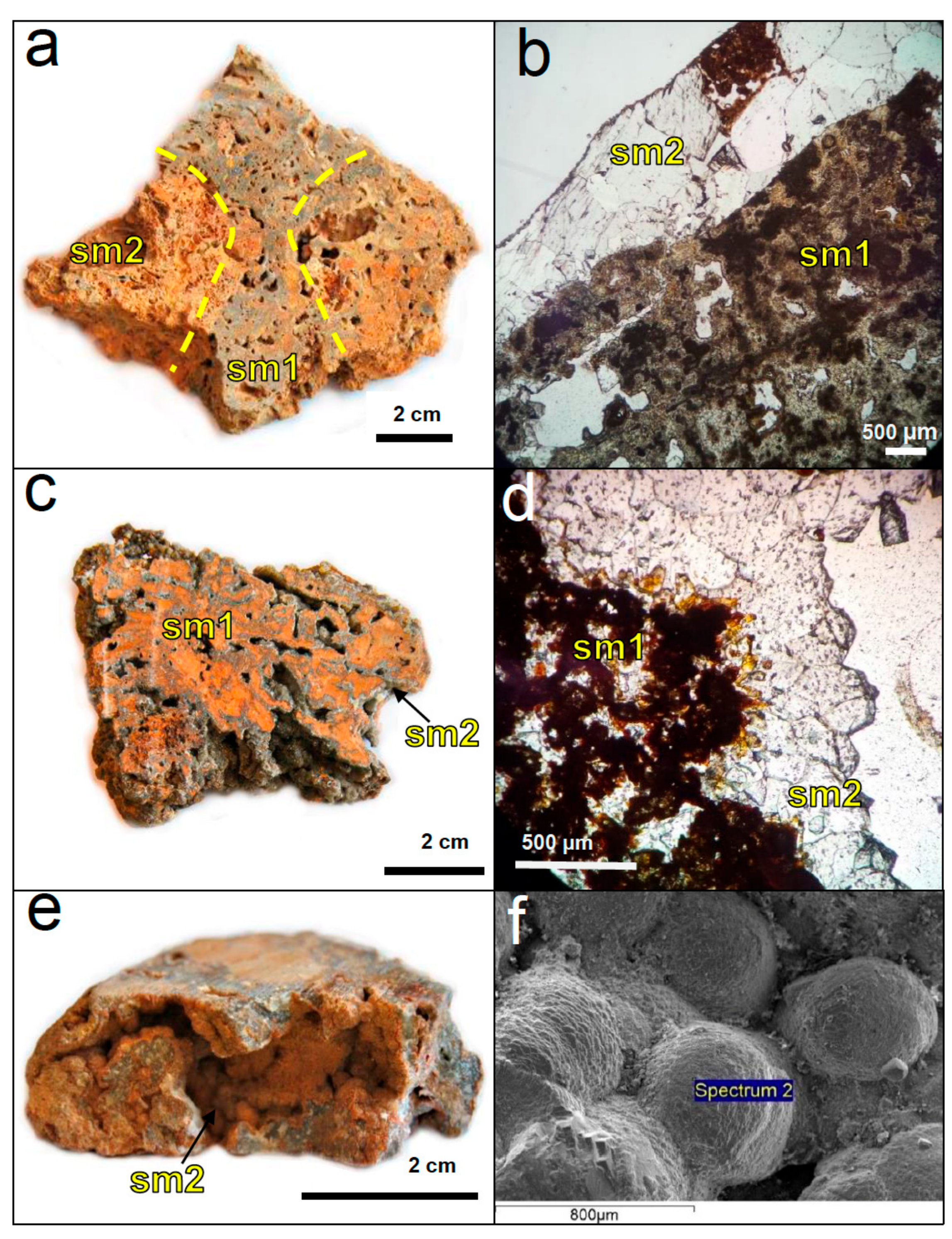
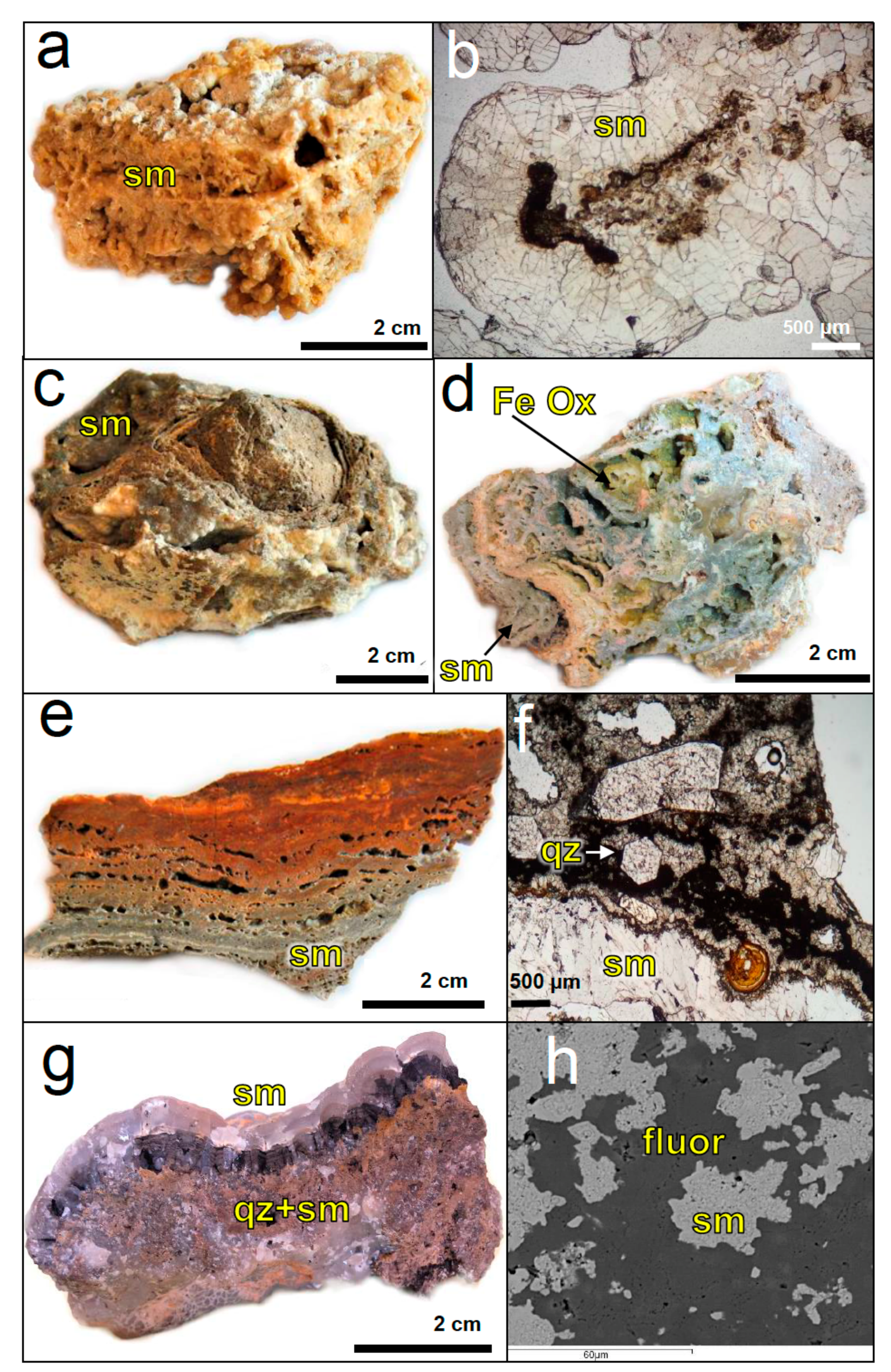
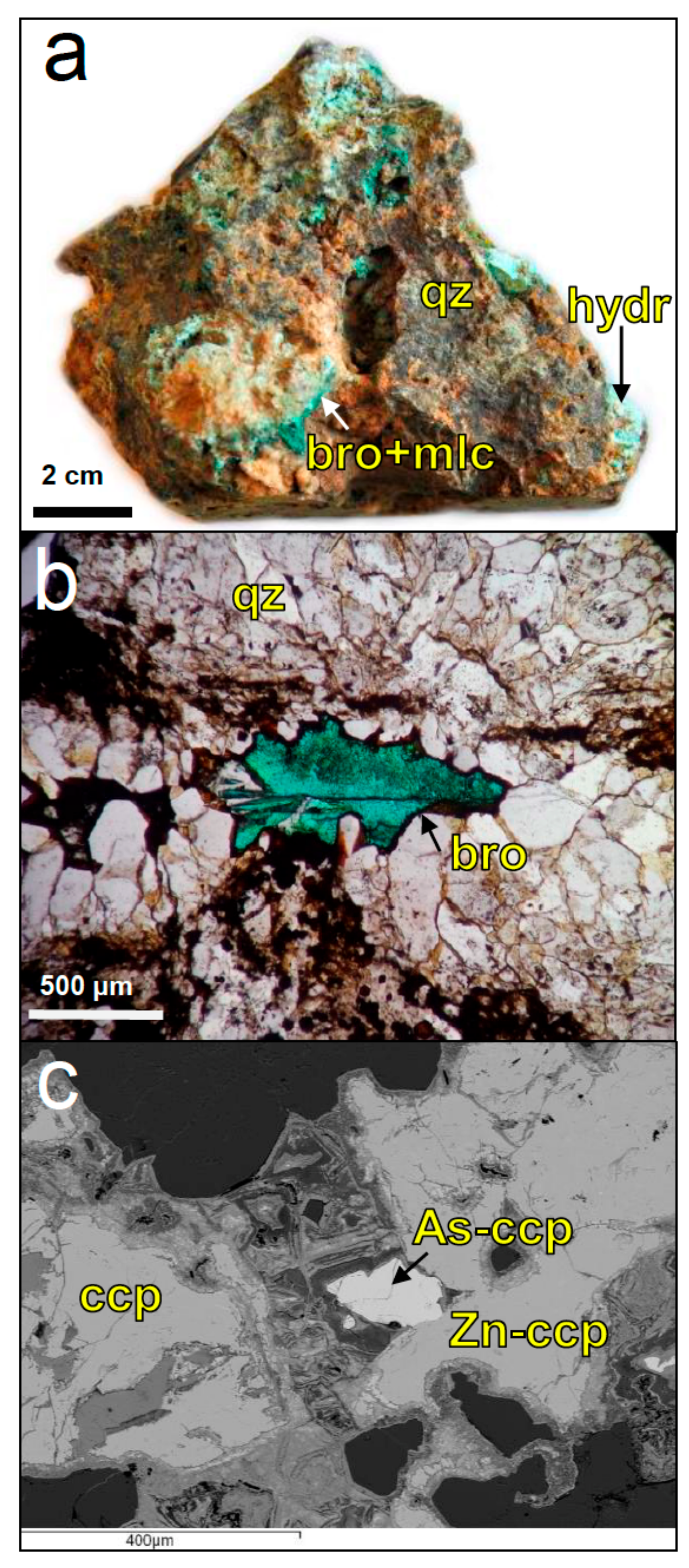
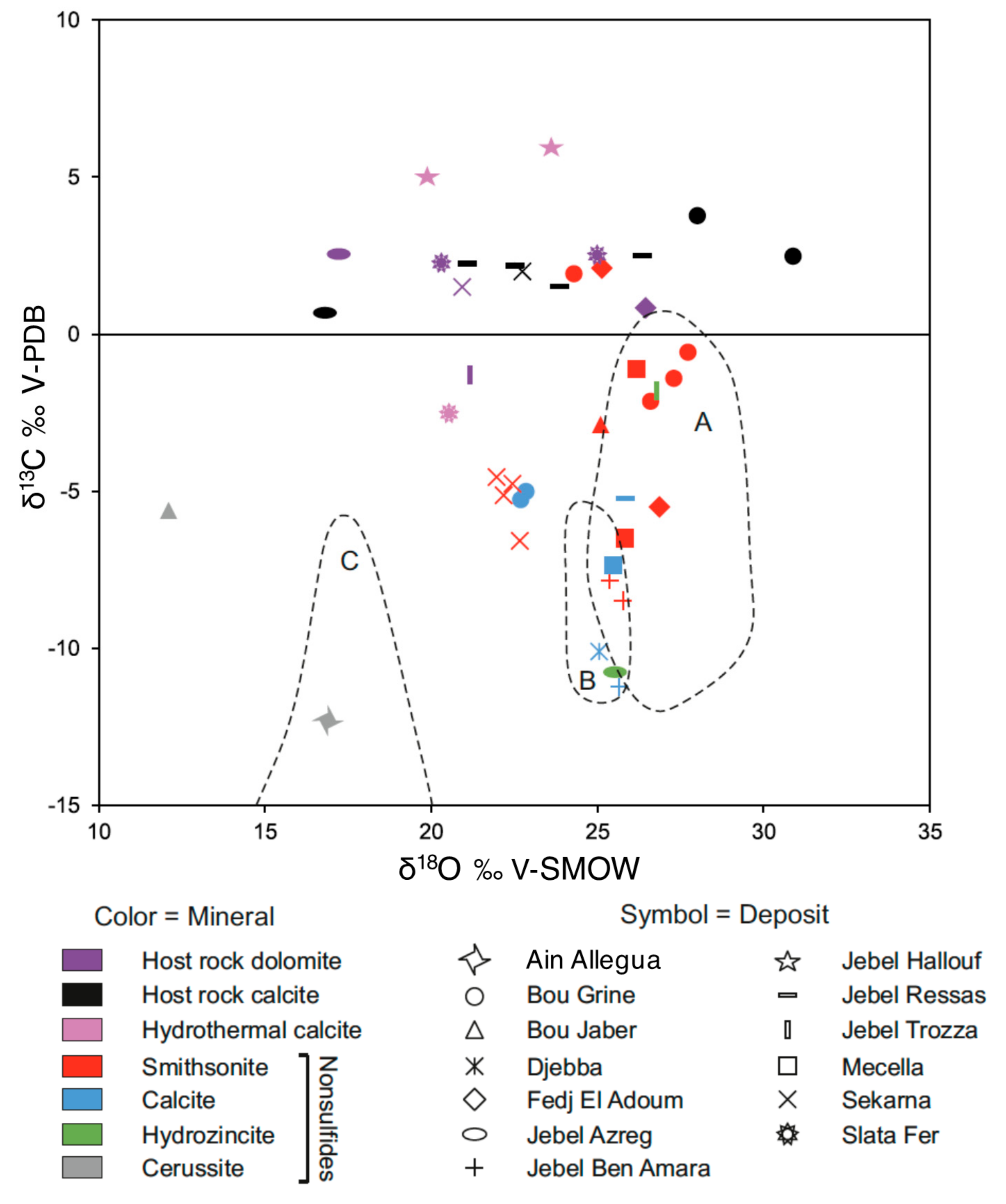
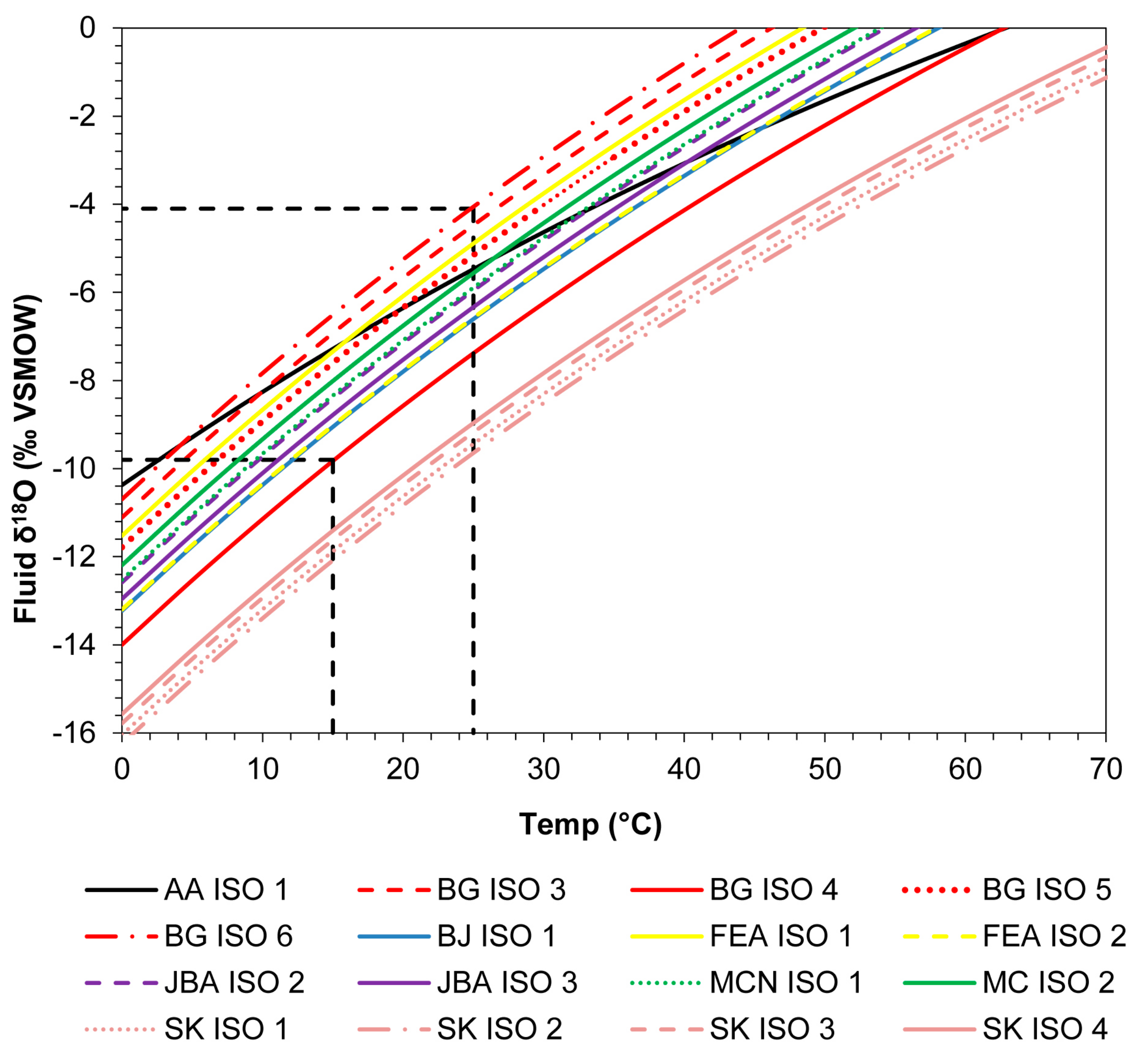
| Host Rock | Hypogene Mineralization | Supergene Mineralization | ||||||||||||||||||||||
|---|---|---|---|---|---|---|---|---|---|---|---|---|---|---|---|---|---|---|---|---|---|---|---|---|
| Zone | Deposit | Sample ID | cal | dol | sph | gal | py | ccp | h cal | dol | qz | fl | cel | sm | hem | ce | hydr | angl | goe | dscz | brc | mlc | s cal | kln |
| Nappe Zone | Ain Allegua | AA | X | X | X | X | ||||||||||||||||||
| Jebel Ben Amara | JBA | X | X | |||||||||||||||||||||
| Jebel Hallouf | JH | X | X | X | X | |||||||||||||||||||
| Diapir Zone | Djebba | DJ | X | X | X | |||||||||||||||||||
| Fedj El Adoum | FEA | X | X | X | X | X | X | X | ||||||||||||||||
| TD | X | |||||||||||||||||||||||
| Bou Grine | BG 1 | X | X | |||||||||||||||||||||
| BG 2 | X | X | ||||||||||||||||||||||
| BF | X | |||||||||||||||||||||||
| Bou Jaber | BJ 1 | X | X | X | ||||||||||||||||||||
| BJ 2 | X | X | X | X | ||||||||||||||||||||
| Slata Fer | SF | X | X | |||||||||||||||||||||
| SFH | X | |||||||||||||||||||||||
| Graben Zone | Jebel Trozza | JT | X | X | X | X | X | X | X | X | ||||||||||||||
| Sekarna | SK 1-St. Pierre | X | X | |||||||||||||||||||||
| SK 2-St. Pierre | X | |||||||||||||||||||||||
| SKH 1 | X | |||||||||||||||||||||||
| SKH 2 | X | |||||||||||||||||||||||
| N-S Axis Zone | Mecella | MC | X | X | X | X | X | |||||||||||||||||
| MCN | X | X | ||||||||||||||||||||||
| Jebel Ressas | JR | X | X | X | X | X | X | X | X | X | ||||||||||||||
| JRH | X | |||||||||||||||||||||||
| LC | X | |||||||||||||||||||||||
| Jebel Azreg | JA | X | X | X | X | X | X | X | X | X | ||||||||||||||
| Zone | Deposit | Sample ID | Subsample ID | Mineral | Description | δ13C ‰ (V-PDB) | δ18O ‰ (V-SMOW) | Reference |
|---|---|---|---|---|---|---|---|---|
| Nappe Zone | Ain Allegua | AA | AA ISO 1 | ce | cerussite crust above galena | −12.21 | 16.88 | This study |
| Jebel Ben Amara | JBA | JBA ISO 3 | sm1 | concretionary smithsonite | −7.83 | 25.37 | This study | |
| JBA ISO 2 | sm2 | concretionary smithsonite | −8.49 | 25.76 | This study | |||
| JBA ISO 1 | s cal | supergene calcite | −11.24 | 25.64 | This study | |||
| Jebel Hallouf | JH | JH ISO 1 | h cal | hydrothermal calcite gangue associated with galena | 5.00 | 19.87 | This study | |
| JH ISO 3 | h cal | hydrothermal calcite gangue associated with galena | 5.94 | 23.60 | This study | |||
| Diapir Zone | Djebba | DJ | DJ ISO 1 | s cal | supergene calcite | −10.10 | 25.04 | This study |
| Fedj El Adoum | FEA | FEA ISO 1 | sm | smithsonite associated with sulfides | −5.50 | 26.86 | This study | |
| FEA ISO 2 | sm | concretionary smithsonite with goethite | 2.11 | 25.12 | This study | |||
| TD | TD ISO 1 | dol | Triassic dolomite host rock | 0.84 | 26.44 | This study | ||
| Literature | dol * | banded dolomite in the host rock | 2.9–6.9 | 28.6–30.1 | [56] | |||
| cal * | calcite from the contact zone | −8.1 | 31.6 | [56] | ||||
| Bou Grine | BG 1 | BG ISO 5 | sm2 | smithsonite grey crust | −2.13 | 26.59 | This study | |
| BG ISO 3 | sm1 + sm2 | smithsonite replacing the host rock + smithsonite grey crust | −1.40 | 27.29 | This study | |||
| BG ISO 1 | s cal | supergene calcite following smithsonite | −5.27 | 22.68 | This study | |||
| BG 2 | BG ISO 2 | s cal | supergene calcite following smithsonite | −5 | 22.84 | This study | ||
| BG ISO 6 | sm1 | smithsonite replacing the host rock | −0.57 | 27.72 | This study | |||
| BG ISO 4 | sm3 | smithsonite reddish crust | 1.92 | 24.29 | This study | |||
| BF | BF ISO 1 | cal | Bahloul Formation (Cenomanian-Turonian) host rock | 3.79 | 27.99 | This study | ||
| BF ISO 2 | cal | Bahloul Formation (Cenomanian-Turonian) host rock | 2.50 | 30.81 | This study | |||
| Literature | cal * | supergene calcite | −12–−4 | 19–25 | [4] | |||
| Bou Jaber | BJ 1 | BJ ISO 1 | sm | smithsonite concretion | −2.87 | 25.09 | This study | |
| BJ 2 | BJ ISO 2 | ce | cerussite crystals over galena vein | −5.62 | 12.09 | This study | ||
| Literature | cal * | host rock | 0.1–3.9 | 26.2–30.1 | [5] | |||
| Slata Fer | SF | SF ISO 1 | h cal | hydrothermal calcite | −2.52 | 20.4 | This study | |
| SFH | SFH ISO 1 | dol | Aptian dolomite host rock | 2.27 | 20.3 | This study | ||
| SFH ISO 2 | dol | Aptian dolomite host rock | 2.52 | 24.98 | This study | |||
| Graben Zone | Jebel Trozza | JT | JT ISO 2 | hydr | hydrozincite veinlet | −1.78 | 26.78 | This study |
| JT ISO 3 | dol | dolomite host rock | −1.3 | 21.16 | This study | |||
| Sekarna | SK 1-St. Pierre | SK ISO 1 | sm2 | yellowish - white concretionary smithsonite-type 2 | −5.13 | 22.17 | This study | |
| SK 2-St. Pierre | SK ISO 2 | sm1 | concretionary smithsonite-type 1 | −4.55 | 21.96 | This study | ||
| SK ISO 3 | sm1 | concretionary smithsonite-type 1 | −4.76 | 22.44 | This study | |||
| SK ISO 4 | sm2 | white concretionary smithsonite-type 2 | −6.57 | 22.66 | This study | |||
| SKH 1 | SKH ISO 1 | dol | Metlaoui Group (Eocene) host rock | 1.50 | 20.93 | This study | ||
| SKH 2 | SKH ISO 2 | cal | Abiod Formation (Campanian-Maastrichtian) host rock | 2.01 | 22.73 | This study | ||
| Literature | St. Eugene | sm * | - | −5.1 | 28.3 | [47] | ||
| dol * | host rock | −2.3 to 2.6 | 21.6 to 23.9 | [47] | ||||
| N-S Axis Zone | Mecella | MC | MC ISO 2 | sm | banded smithsonite | −1.09 | 26.17 | This study |
| MC ISO 1 | s cal | banded calcite | −7.34 | 25.46 | This study | |||
| MCN | MCN ISO 1 | sm | colloform smithsonite | −6.49 | 25.83 | This study | ||
| Jebel Ressas | JR | JR ISO 1 | s cal | concretionary calcite | −5.22 | 25.83 | This study | |
| JR ISO 2 | cal | carbonate host rock | 1.53 | 23.84 | This study | |||
| JRH | JRH ISO 1 | cal | Jurassic carbonate host rock | 2.51 | 26.33 | This study | ||
| LC | LC ISO 1 | cal | Oust Formation (Early Jurassic) reef limestone host rock | 2.26 | 21.06 | This study | ||
| LC ISO 2 | cal | Oust Formation (Early Jurassic) reef limestone host rock | 2.20 | 22.5 | This study | |||
| Literature | cal * | post-ore calcite | 0.9 | 24.8 | [60] | |||
| dol * | host rock | 0.14 to 0.7 | 19.2 to 26.5 | [60] | ||||
| Jebel Azreg | JA | JA ISO 4 | hydr | hydrozincite concretion in cavity | −10.76 | 25.52 | This study | |
| JA ISO 1 | cal | calcite host rock | 0.69 | 16.79 | This study | |||
| JA ISO 2 | dol | dolomite host rock | 2.55 | 17.21 | This study |
© 2018 by the authors. Licensee MDPI, Basel, Switzerland. This article is an open access article distributed under the terms and conditions of the Creative Commons Attribution (CC BY) license (http://creativecommons.org/licenses/by/4.0/).
Share and Cite
Garnit, H.; Boni, M.; Buongiovanni, G.; Arfè, G.; Mondillo, N.; Joachimski, M.; Bouhlel, S.; Balassone, G. C–O Stable Isotopes Geochemistry of Tunisian Nonsulfide Zinc Deposits: A First Look. Minerals 2018, 8, 13. https://doi.org/10.3390/min8010013
Garnit H, Boni M, Buongiovanni G, Arfè G, Mondillo N, Joachimski M, Bouhlel S, Balassone G. C–O Stable Isotopes Geochemistry of Tunisian Nonsulfide Zinc Deposits: A First Look. Minerals. 2018; 8(1):13. https://doi.org/10.3390/min8010013
Chicago/Turabian StyleGarnit, Hechmi, Maria Boni, Giuliana Buongiovanni, Giuseppe Arfè, Nicola Mondillo, Michael Joachimski, Salah Bouhlel, and Giuseppina Balassone. 2018. "C–O Stable Isotopes Geochemistry of Tunisian Nonsulfide Zinc Deposits: A First Look" Minerals 8, no. 1: 13. https://doi.org/10.3390/min8010013




